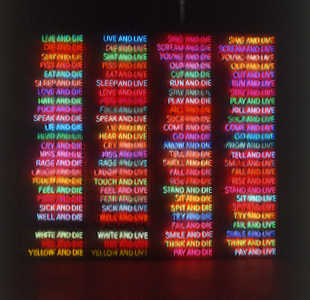While we were in Japan, we made a detour to see the growing collection of contemporary art on Naoshima, a tiny island near Okayama, and within spitting distance of the massive Seto Inland Sea Bridge.
 In explaining Naoshima, I’ve taken to calling it the Marfa of Japan, but that’s only partly accurate. Benesse represents one collector’s–not an artist’s–increasingly significant attempt to create an internationally recognized destination for contemporary art pilgrims and to revitalize/transform a dying town in the process. I think it’s mostly successful, and definitely worth the trip.
In explaining Naoshima, I’ve taken to calling it the Marfa of Japan, but that’s only partly accurate. Benesse represents one collector’s–not an artist’s–increasingly significant attempt to create an internationally recognized destination for contemporary art pilgrims and to revitalize/transform a dying town in the process. I think it’s mostly successful, and definitely worth the trip.
Benesse Art Site is the new umbrella moniker for four separate art projects: the just-opened Chichu Museum; Benesse House, a small museum/hotel; Seaside Park, a campground surrounded by outdoor sculptures; and Art House, permanent artist installations in abandoned 18th century buildings.
When we arrived on Naoshima, we headed first to Benesse House, which was designed by Tadao Ando. The staff was extremely helpful, even though we knew we couldn’t stay overnight (the hotel fills up a year in advance). The building was impressive, with two or three of the sublime moments Ando’s Fort Worth Museum has dozens of.
The work was all over the place; there’s stuff from a collecting phase where money outstripped sense, then from the “let’s open a museum” phase where sense caught up. Exquisite siting was a recurring theme. Hiroshi Sugimoto’s Time Exposed seascape photos, installed in a courtyard overlooking the sea; Yoshihiro Suda’s invisible Weeds, and Bruce Nauman’s neon 100 Live or Die, which, by restrictions on how frequently it would be turned on, was transformed from sculpture to eagerly awaited performance spectacle.
A businessman on the ferry had boasted, “There’s a $6 million Monet up there.” [A Water Lilies diptych, which was probably more than that.] Meanwhile, the locals remain unimpressed by the $10 million early Johns hanging next to the Zen-like Pollock.
I’ve mentioned it before, but I’ll post more on the Art House Project later.
Benesse Art Site Naoshima, the Marfa of Japan
While we were in Japan, we made a detour to see the growing collection of contemporary art on Naoshima, a tiny island near Okayama, and within spitting distance of the massive Seto Inland Sea Bridge.
 In explaining Naoshima, I’ve taken to calling it the Marfa of Japan, but that’s only partly accurate. Benesse represents one collector’s–not an artist’s–increasingly significant attempt to create an internationally recognized destination for contemporary art pilgrims and to revitalize/transform a dying town in the process. I think it’s mostly successful, and definitely worth the trip.
In explaining Naoshima, I’ve taken to calling it the Marfa of Japan, but that’s only partly accurate. Benesse represents one collector’s–not an artist’s–increasingly significant attempt to create an internationally recognized destination for contemporary art pilgrims and to revitalize/transform a dying town in the process. I think it’s mostly successful, and definitely worth the trip.
Benesse Art Site is the new umbrella moniker for four separate art projects: the just-opened Chichu Museum; Benesse House, a small museum/hotel; Seaside Park, a campground surrounded by outdoor sculptures; and Art House, permanent artist installations in abandoned 18th century buildings.
When we arrived on Naoshima, we headed first to Benesse House, which was designed by Tadao Ando. The staff was extremely helpful, even though we knew we couldn’t stay overnight (the hotel fills up a year in advance). The building was impressive, with two or three of the sublime moments Ando’s Fort Worth Museum has dozens of.
The work was all over the place; there’s stuff from a collecting phase where money outstripped sense, then from the “let’s open a museum” phase where sense caught up. Exquisite siting was a recurring theme. Hiroshi Sugimoto’s Time Exposed seascape photos, installed in a courtyard overlooking the sea; Yoshihiro Suda’s invisible Weeds, and Bruce Nauman’s neon 100 Live or Die, which, by restrictions on how frequently it would be turned on, was transformed from sculpture to eagerly awaited performance spectacle.
A businessman on the ferry had boasted, “There’s a $6 million Monet up there.” [A Water Lilies diptych, which was probably more than that.] Meanwhile, the locals remain unimpressed by the $10 million early Johns hanging next to the Zen-like Pollock.
I’ve mentioned it before, but I’ll post more on the Art House Project later.
